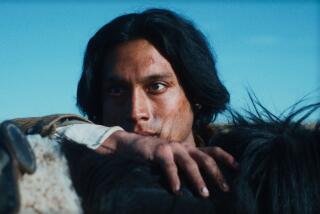CHRONICLE OF THE GUAYAKI INDIANS. <i> By Pierre Clastres</i> .<i> Translated from the French by Paul Auster</i> .<i> Zone Books: 352 pp., $25.50</i>
- Share via
Savages have fascinated civilization at least since Herodotus. The Rousseauian idea that they are freer and happier than civilized people has played a part in this fascination, but that idea probably isn’t fundamental to it. The civilized have despised the uncivilized, on the whole, and they still do despite modern cultural relativism. (The poor box-office returns from the 1992 film of Peter Matthiessen’s Amazon novel, “At Play in the Fields of the Lord,” perhaps reflect this.) French anthropologist Pierre Clastres probably comes much closer to explaining the fascination’s true source in his splendid “Chronicle of the Guayaki Indians.”
Clastres’ book is an unexpected echo of a time that seems at once close and distant. Hardly any peoples like these South American Indians exist today, yet they lived and died only four decades ago. Many indigenous groups persist, of course, but very few are as innocent of civilization as the Guayaki were. Such innocence has not survived. By the time of “Chronicle’s” original French publication in 1972, the tribe Clastres had studied already had declined from 100 individuals to 30, mostly because of diseases caught from whites (including Clastres, presumably). By the time Clastres died in a car accident in 1977, they probably were extinct. Their fate might never have come to North America’s attention if novelist Paul Auster, who translated “Chronicle” as a penniless unknown in 1976, hadn’t become bankable enough in 1996 finally to get it published here.
Reading “Chronicle” is like opening a time capsule containing a once-familiar image--the savage--that has assumed a strange, unsettling aspect after its virtual disappearance from the living world. I say unsettling because Clastres’ fine book is not quite the nostalgic view of primitive life that now prevails in literary circles.
Clastres spent most of 1963 with two Guayaki groups that recently had contacted civilization. He noted that the Paraguayan farmers who lived near them--farmers who themselves spoke a native language, Guarani--regarded them with mingled hatred and awe as “superhuman in the sense that they were spirits of the forest with fearful powers and knowledge.” People who live settled on farms and in towns feel alien to those who wander around hunting and gathering, no matter what their genetic or cultural kinship to them.
Yet Clastres posed a paradox when he offered this insight. A major theme in his “Chronicle” is the superficiality of regarding the savage as a “spirit of the forest,” a being closer to nature than other humans. To be sure, the Guayaki could move through the Chacoan forest and exploit its resources with skills no Guarani or beeru (white man) could match, yet as Clastres described them, those skills did not give them any special power over or kinship with nature, particularly not in the realm most important to them, that of spirits. They seemed to regard nature spirits--the blue jaguar of night, the great serpent of the rainbow--with a hatred and awe not unlike that of their Guarani-speaking neighbors and spent much of their time performing rituals to deflect the spirits’ malignancy.
According to Clastres, the savages were as clear in their sense of a fundamental separateness between culture and nature, as determined to “get rid of everything that might be a disagreeable reminder of the ugliness and stupidity of animals,” as the most etiolated urbanite. “One preoccupation is shared by all Indians,” he wrote, “to keep reaffirming their humanity and protecting it from the natural world, protecting themselves from being swallowed up by the savagery of nature, which is always on the lookout for human beings, always eager to reclaim them.” The common Indian practice of removing all animal-like body hair is a basic example of this. Indeed, the Guayaki saw the hairy Paraguayan whites who invaded the forest to kill or enslave them as akin to, or having power over, the baleful nature spirits.
Clastres’ interpretation of Guayaki thought seems almost counterintuitive at a time when many Westerners automatically regard uncivilized cultures as environmentally positive alternatives to an ecosystem-destroying global marketplace. On the one hand, this is a refreshing antidote to much sentimentality that has grown up around the politically correct version of noble savagery. On the other, it has apocalyptic implications. If the savage--the original human being--hated and feared nature, what does that say for civilization’s chances of developing a less hostile and destructive attitude toward the Earth?
Yet did the savage hate and fear nature? The beliefs of countless savage tribes can’t be extrapolated from the Guayaki. But Clastres did in his excessively sweeping comment that the fear of nature is the “one preoccupation . . . shared by all Indians.” Clastres also might have misinterpreted the Guayaki. As a member of the structuralist school of anthropology led by his mentor, Claude Levi-Strauss, he was predisposed to see stronger oppositions between culture and nature than some scholars. Clastres seemed relatively uninterested in the Guayaki’s relationship to the forest, preferring to stay in camp and question them about their customs, myths and kinship system rather than to accompany them in hunting and gathering. He remarked at one point that his questions often seemed to bore them, and one wonders if he might have evoked more interest by asking about the animals and plants they depended on for their livelihood.
The Guayaki may not have been true savages in the sense of having descended from an unbroken hunting and gathering past. To the extent that Clastres could guess at their origins, based on the writings of 18th century Jesuit Pedro Lozano, he believed they had devolved from a farming society that the Guaranis and Spaniards had defeated and driven into the forest. Clastres thought the Guayaki had lost not only their knowledge of farming but also their original language and religion, since the Guayaki groups he encountered spoke a variant of Guarani and had similar myths. So their compulsion to separate themselves with magic and ritual from nonhuman nature may have been more an expression of a regressed “barbarism” than of a true savagery.
Whatever the validity (now unverifiable) of Clastres’ interpretation of Guayaki thought, his evocation of their lost lives has great charm, an attraction that arises automatically from our civilized fascination with wild people who seem so strange at first, dodging naked through the forest, but who prove to be so much like us in feelings if not in thought and habits. Clastres also was a talented writer, so skillful at leavening his analyses of Guayaki culture with vivid and humorous anecdotes that his book is always lively and often funny. One amusing story recounts his efforts to pry information from an elderly woman by offering her candy (caramelo in Spanish--which the Guayaki pronounced “kramero”): “ ‘Kramero?’ I suggested with an engaging smile. Jakwachugi, however, was a little hard of hearing and did not understand me because her mouth dropped open and her eyes became incredulous. ‘Meno? Meno nde jwe? Make love? You want to make love?’ Instead of ‘kramero,’ she had heard ‘meno,’ which means to make love. . . . The misunderstanding was cleared up, but for several days after that Jakwachugi would look at me with a rather dreamy expression in her eyes.”
Auster’s translation preserves Clastres’ charm well, although there are a few puzzling passages that may arise more from the author’s occasionally gnomic philosophical utterances than from the translation. “Every civilization, of course, has its pagans,” reads part of a paragraph about differences between the Guayaki and the Guarani religions, “but our Christian civilization never hesitated to sing the praises of a God whom other people refused to worship though they were tortured and killed for doing so. This is another way in which the true worth of our world can be measured.” Clastres clearly means that Christianity’s strength has lain in unfailing adherence to its doctrines, but the passage’s significance to the schisms between Guarani and Guayaki religions is unclear.
Clastres’ empathy and talent allowed him to view sympathetically, or at least with a degree of comprehension, the Guayaki’s most unpleasant (if not necessarily most uncivilized) behavior: their occasional killing of younger tribe members for ritual and of aged ones for convenience when they became too feeble to work and their cooking and eating of the dead not only as ritual but because they found human meat fatter and tastier than wild game. He never witnessed cannibalism, but he saw the boiled bones of an infant who had died in his absence, and his second-hand description of the ways his informants feasted on their companions--not something likely ever to appear on PBS Nova--is vivid enough. (Only the Atchei Gatu, the smaller of the Guayaki groups he studied, were cannibals, however; the larger buried their dead.)
It is hard to draw conclusions from a book like this, which follows life’s devious course without the half-truths and evasions that allow easy answers. (Clastres had to dig deep to discover the Atchei Gatu’s cannibalism.) Given its tragic and sometimes gruesome content, “Chronicle” might have been depressing. I didn’t find it so, however. No culture lasts forever, and Clastres evidently felt the Guayaki had been reasonably happy in their forest before civilization engulfed them, a happiness that arose not from being “superhuman spirits of the forest” but from living in relative equality with their fellow tribe members and from moving freely in an environment from which they drew a satisfying living. According to Clastres, their happiness came less from their power over nature than from a lack of it, an interpretation all the more fascinating at a time when civilization’s “fearful powers and knowledge” seem to be growing uncontrollably, ominously. “It was fatal to the Indians, “ Clastres gnomically wrote of Western civilization’s arrival in America, “but by some strange twist of fate it might also turn out to be the cause of the unexpected death of our own history, the history of our world in its present form.”
More to Read
Sign up for our Book Club newsletter
Get the latest news, events and more from the Los Angeles Times Book Club, and help us get L.A. reading and talking.
You may occasionally receive promotional content from the Los Angeles Times.







